
Penstemon, the beardtongues, is a large genus of roughly 280 species of flowering plants native mostly to the Nearctic, but with a few species also found in the North American portion of the Neotropics. It is the largest genus of flowering plants endemic to North America. As well as being the scientific name, penstemon is also widely used as a common name for all Penstemon species alongside beardtongues.

Penstemon palmeri, known by the common name Palmer's penstemon, is a species of perennial flowering plant in the genus Penstemon that is notable for its showy, rounded flowers, and for being one of the few scented penstemons. The plant, in the family Plantaginaceae, is named after the botanist Edward Palmer.
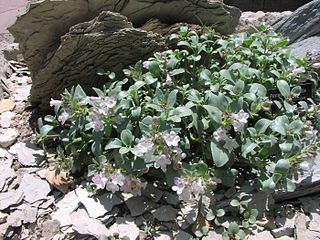
Penstemon debilis, the Parachute penstemon or Parachute beardtongue, is one of the rarest plants in North America, found only 5 places in the world, all of them located on the Roan Plateau in Garfield County, of Western Colorado. The Denver Botanic Gardens has the Parachute penstemon on display with other native plants of the Roan Plateau. The name Parachute comes from the small town in Colorado, Parachute, Colorado, close to where the plant can be found.

Keckiella is a genus of plants in the plantain family. It includes several species of plants known commonly as keckiellas. A few species may be called beardtongues or penstemons because all keckiellas once belonged to genus Penstemon as the section Hesperothamnus. Keckiellas are native to the American southwest, especially California. They bloom in attractive snapdragon-like flowers. Genus Keckiella was named after the American botanist David D. Keck.
Penstemon barnebyi is a species of penstemon known by the common names White River Valley beardtongue and Barneby's beardtongue. It is native to the mountain and basin territory of central western Nevada, where it grows in sagebrush and woodland; there is also one occurrence just over the California border. This is a hairy perennial herb with erect branches reaching 30 centimeters (1 ft) in maximum height. The oppositely arranged leaves are lance-shaped and up to 7.5 centimeters (3 in) long. There are usually several located around the base of the plant. The inflorescence produces tubular flowers just over one-half centimeter long. They are light purple with a purple-striped white throat lined with yellowish hairs. The protruding staminode is covered in bright orange hairs.
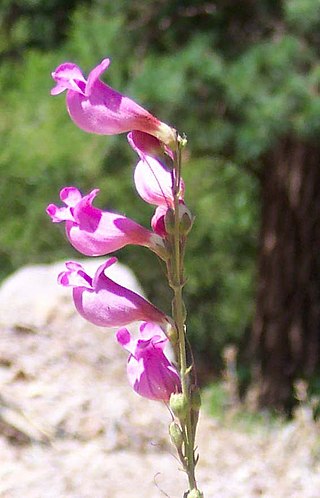
Penstemon floridus is a species of flowering plant in the plantain family known by the common names Panamint beardtongue and rose penstemon.

Penstemon grandiflorus, the large-flowered beardtongue or large beardtongue, is a perennial flowering plant endemic to the United States. It is considered a synonym for Penstemon bradburyi by Plants of the World Online.
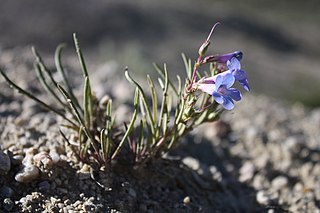
Penstemon penlandii is a rare species of flowering plant in the plantain family known by the common names Penland penstemon and Penland's beardtongue. It is endemic to Colorado in the United States, where it is known only from a strip of land about five miles long in central Grand County. There are two occurrences totalling about 8600 individuals. This is a federally listed endangered species of the United States.

Penstemon barrettiae is a species of flowering plant in the plantain family known by the common name Barrett's beardtongue or Barrett's penstemon. It is endemic to a small part of the Pacific Northwest of North America.

Penstemon clutei is a species of flowering plant in the plantain family known by the common name Sunset Crater beardtongue. It is endemic to Arizona, where it is known only from a system of volcanic cinder cones, including Sunset Crater, in Coconino County.

Penstemon scariosus is a species of flowering plant in the plantain family known by the common name White River beardtongue. It is native to Colorado, Utah, and Wyoming in the United States.
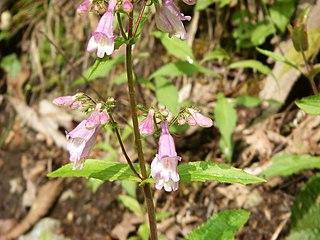
Penstemon canescens is a species of penstemon in the family Plantaginaceae. P. canescens is known by the common names Eastern gray beardtongue or Appalachian beardtongue. It is native to woodlands, forest edges, and roadsides of the southeastern United States and flowers May through July. It is a perennial herb producing stems reaching one meter in maximum height. Penstemon canescens has been used by Native Americans for thousands of years.
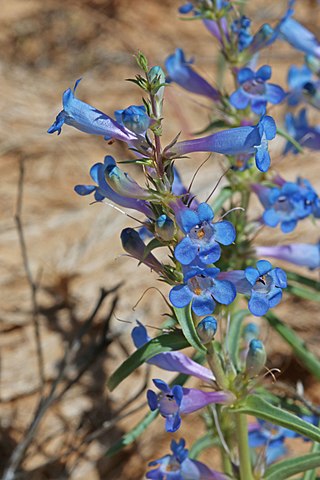
Penstemon angustifolius is a species of flowering plant in the plantain family known by the common names broadbeard beardtongue and narrowleaf beardtongue. It is native to the west-central United States, including the Great Plains.
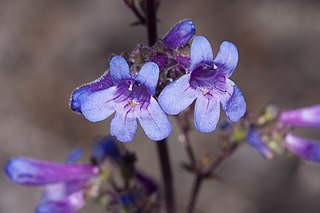
Penstemon humilis is a species of flowering plant in the plantain family known by the common names low beardtongue and lowly beardtongue. It is native to the western United States.

Penstemon davidsonii is a species of penstemon known by the common name Davidson's penstemon, honoring Dr. George Davidson. It is native to North America from the Sierra Nevada Range in California and Nevada through the Coast and Cascade ranges of Oregon and Washington into British Columbia.

Penstemon tubaeflorus, common name white wand beardtongue, is a species of Penstemon found in the United States and the lower parts of Canada.
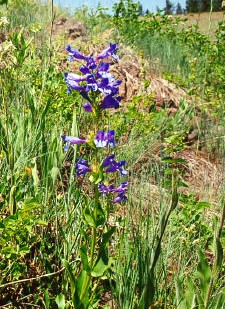
Penstemon pennellianus, often called the Blue Mountain beardtongue or Blue Mountain penstemon, is a species of beardtongue native to Washington and Oregon.

Penstemon whippleanus, commonly known as dusky penstemon, dusky beardtongue, Whipple's penstemon, or Whipple's beardtongue, is a summer blooming perennial flower in the large Penstemon genus. It is a widespread plant within the hemiboreal forests of the Rocky Mountains in North America. It is noted for the large deep purple-red flowers and a preference for high mountain elevations.
This page is based on this
Wikipedia article Text is available under the
CC BY-SA 4.0 license; additional terms may apply.
Images, videos and audio are available under their respective licenses.



















